Sigma 105 mm f/2.8 EX DG OS HSM Macro
3. Build quality and image stabilization
The comparison of the Sigma’s 105 mm OS dimensions to those of other lenses can be easier if you look at the picture below, in which the Sigma is positioned next to the rival Canon 100L Macro and the Sigma 1.4/30.
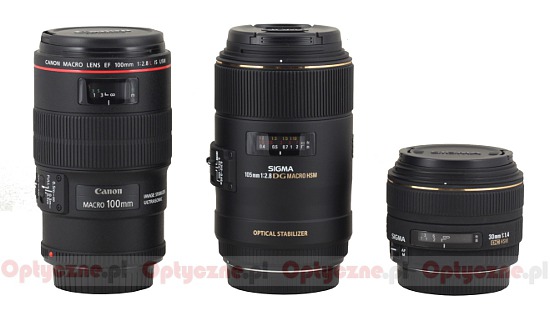 |
Please Support UsIf you enjoy our reviews and articles, and you want us to continue our work please, support our website by donating through PayPal. The funds are going to be used for paying our editorial team, renting servers, and equipping our testing studio; only that way we will be able to continue providing you interesting content for free. |
- - - - - - - - - - - - - - - - - - - - - - - - - - - - - - - - - - - - - - - - - - - - - - - -
The lens starts with a metal mount with contacts. Inside the mount you can find a rear element, set about 1.5 centimeters deep. It is less than three centimeters in diameter and immobile. The problem is that you can find a noticeably big crack around it through which you can see electronics components. As the element itself already doesn’t move, would it be actually so difficult to make sure there were no gaps around it so the lens was completely sealed? The EX series obliges to high quality, after all.
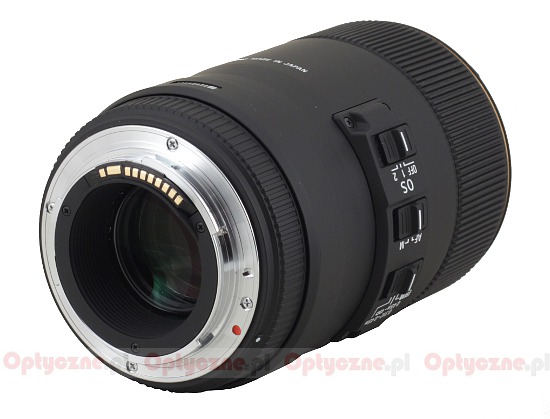 |
Immediately after the mount, already on the proper casing, there is a ribbed, immobile ring which passes into a smooth part of the lens itself. First you can see an inscription OPTICAL STABILIZER, informing us that an optical image stabilization system was implemented here. Almost 3 centimeters further you get to the name of the lens and its parameters. To the left (looking from the top) there is a whole series of different switches. The first is used to choose the autofocus range limit, with the following options: FULL, from 0.45 of a meter to infinity and from 0.312 to 0.45 of a meter. The next switch gives us an opportunity to choose a mode of focusing mechanism (AF/MF). It’s worth adding that even if you choose the AF mode you can still turn the manual focus ring correcting your settings. The last switch is used to control the stabilization mechanism. Here you have three options available: OFF, 1 and 2. Mode 1 is used to normal photography and Mode 2 to shoot moving objects. Behind the switches we can also find an inscription MADE IN JAPAN.
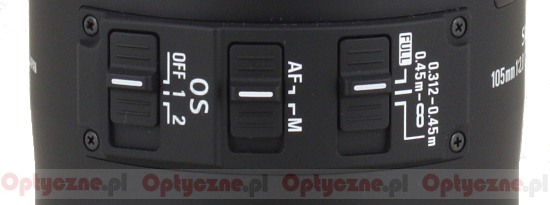 |
Moving further toward the front element there is also a clear distance scale, expressed in feet and meters and hidden behind a window, with some additional reproduction scale markings. Unfortunately the producer didn’t equip the lens with any depth of field scale.
The next part of the lens is a manual focus ring, 32 mm wide, on which you can find rubber ribs and a golden stripe, so characteristic for the EX series. The ring moves smoothly and is well-damped, allowing very delicate and precise movements. Running through the whole distance scale takes a turn through about 140 degrees. When you use the limiter and work in the range from 0.45 of a meter to infinity, the full run needs a turn through only 60 degrees (the range from 1 meter to infinity needs a turn through only more than a dozen degrees). It is definitely too little to get precise manual settings in the normal photography mode.
In the further part of the lens we find a hood mount and inside, you can see a non-rotating filter thread, 62 mm in diameter and a front element. The element is 41 mm in diameter and it remains immobile. When we take photos in 1:1 reproduction ratio the photographed object is situated in a distance of 142 mm from the front element.
The hood can be attached to the lens directly or with a special extender. It allows to screen the lens from sidelight but it doesn’t cause any vignetting only while working with reflex cameras featuring APS-C/DX class detectors or smaller.
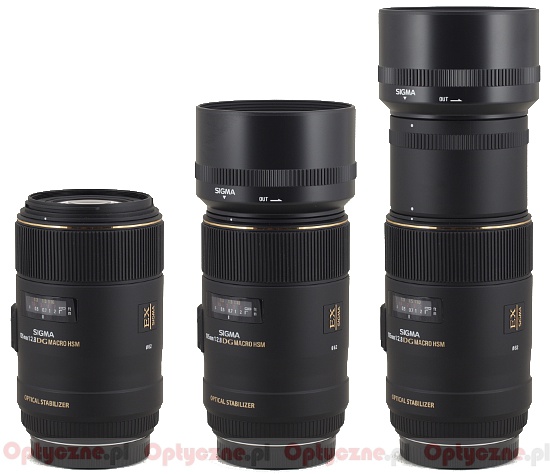 |
When it comes to the inner construction we deal here with 16 elements positioned in 11 groups – it is clear the Sigma 105 mm OS is the most complicated Macro 100 mm class lens of all. The producer boasts of using two low-dispersion SLD glass elements. Inside the lens we can also find a circular aperture with nine diaphragm blades which can be closed down to the value of f/22. It is a huge difference, compared to the predecessor, which could be closed down even to f/45.
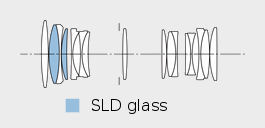
As usual in the case of a Sigma, the buyer gets a rich accessory kit - there are both caps, a hard case with a strap and a hood with an extender in the box. It’s worth adding that the lens comes with a three-year warranty which can be extended, for additional fee, to five years.
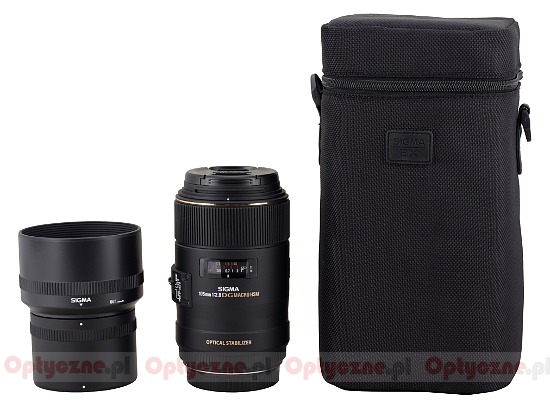 |
The focal length of a lens is always determined for rays falling from infinity. That’s why it changes even in fixed focal lenses, where focusing consists of changing the mutual position of elements. It is especially significant in the case of macro lenses, where, while passing from infinity to 1:1 reproduction ratio, a very drastic change of the position of elements is needed.
That’s why we decided to use an optical bench and measure the focal lengths of the tested lens very thoroughly. Getting down to the facts our measurements showed that the Sigma 2.8/105, set at infinity, has a focal length of 101.9 mm with the measurement error not exceeding 0.1 mm. When you take photos using 1:1 reproduction ratio the focal length changes its value to 74.9 mm (here also the error is less than 0.1 mm). Working in the macro mode you must remember that our lens is not a 2.8/105 instrument but rather a 5.6/75 lens.
Stabilization
Sigma declares unvaryingly that the stabilization efficiency in its lenses reaches 4 EV. We decided to check it. In order to do so for every exposure time ranging from 1/160 to 1/5 of a second we took several dozen photos with the stabilization switched on and off. In both cases we computed the percentage of blurred photos and showed it as a graph of the exposure time function, expressed in EV, where the 0E V point is the equivalent of 1/125 of a second.
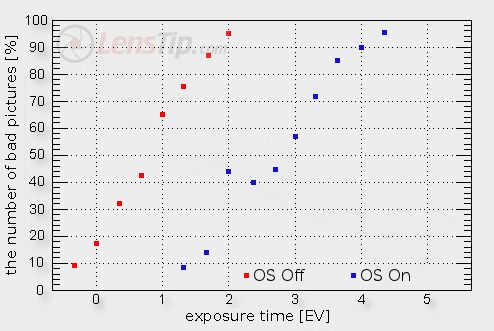
As you see, the declared 4 EV are simply out of question. A maximum distance between two curves reaches 2.3-2.5 EV and we determined the value of the tested Sigma’s stabilization system as such. The result is a bit surprising because in latest stabilized devices Sigma could already reach the level of 3 EV. Despite that the result is comparable to those of most of stabilized sensors in cameras so there are no serious reasons to complain.






